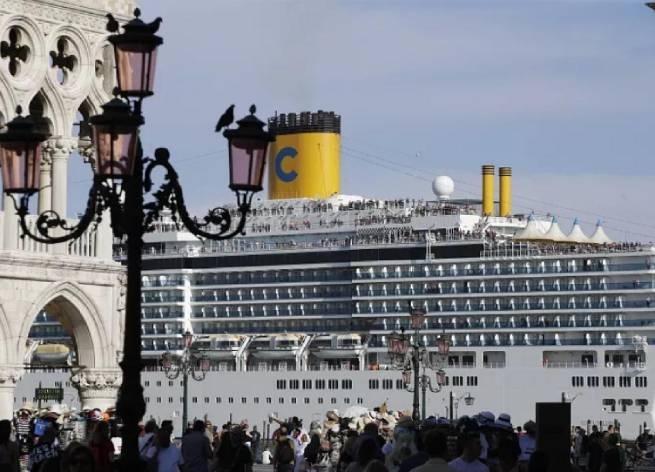Cruise on the sea – what could be more attractive for a good rest? No wonder every year about 5 million people (before the pandemic 30 million) go on a sea voyage.
The maximum comfort on a cruise is combined with sightseeing of the most famous and noteworthy sights, which attracts travel lovers. But residents of port cities are not at all happy with such an influx of guests, and the authorities are puzzling over new restrictions for tourists. Why?
The cruise industry is successfully and rapidly recovering from the devastating effects of COVID-19, but many ports where ships anchor are reconsidering their attitude towards them. Other port cities are ready to ban cruises altogether, citing social, environmental and economic problems.
In 2021, Venice banned large cruise ships from anchoring in its historic centre. UNESCO has threatened to list the Italian city as endangered unless cruise ships are banned. Experts say they are causing pollution and rapidly destroying the foundations of a city already suffering from floods.
Due to the ban, large cruise ships will no longer be able to enter the Giudecca Canal in Venice, which leads to the famous Saint Mark’s Square. Similar attempts were made before, but then the old rules were canceled. However, in 2019, when a cruise ship crashed into the harbor of Venice, injuring five people, the pressure increased. In 2021, even cruise lines are in favor of a ban.
Following the announcement of the new rules, the Cruise Lines International Association (CLIA) said it had “supported the new approach for many years”, calling it “an important step forward”. Other countries may soon follow Venice’s example. For example, Barcelona Mayor Ada Colau recently announced that she would limit the number of cruise tourists in the city if she is re-elected in May. In an interview with The Times, she said:
“40% of cruise ships stop for four hours. They don’t provide an economic return to the city, with thousands of people disembarking, creating big mobility problems and then leaving. This is an industry that we need to limit.”
Pollution is also a concern in Barcelona, which ranked first among cruise ports for air pollution in Europe in a study last year by Transport & Environment. The new measures could halve the number of people disembarking, which could be as high as 200,000 per month during the peak season.
The mayor of Marseille, France’s largest cruise port, also spoke out against the cruise industry. He stated that it “suffocates” the city with air pollution. Restrictions for cruise companies have tightened Amsterdam, Santorini and Dubrovnik. And this phenomenon is not limited to Europe. Around the world, port cities decide they don’t want to go back to the way they were before.
California’s Monterey Bay has had virtually no ships since the start of the COVID-19 pandemic. Some operators were planning to return, but in February the city sent a clear message to the cruise lines that it did not want them back. The City Council does not have the power to ban cruise ships. Instead, Monterey has canceled drop-off services, which means cruise operators will have to hire staff to clear passengers at the city’s docks. Monterey city manager Hans Uslar wrote in his report:
“I hope this move sends a message to cruise ships that they are no longer welcome in our city.”
City officials say they want to avoid “accidental release of water into pristine Monterey Bay” and protect the area’s coastal environment, one of more than 9,000 square meters of Monterey Bay National Marine Sanctuary. km.
Bar Harbor in the U.S. state of Maine also decided in November to impose severe restrictions on the number of tourists who can disembark from ships. From next year, their daily number – passengers and crew members – will not exceed 1,000 people. The average number of people on a cruise ship is about 3,000 people, so the innovation will be a serious blow to those wishing to dock.
Authorities imposed the restrictions after local residents petitioned to limit the number of tourists, saying they were “overwhelmed” by cruise traffic. And no wonder: a survey conducted in 2021 showed that the majority of Bar Harbor residents are unhappy with these huge ships. More than 50% said that cruise tourism has more negative than positive impact on Bar Harbor. The quality of life, according to respondents, has decreased due to this industry by more than half.
Advocates of cruise ship preservation claim that their contribution to the local economy is large enough to be neglected. But is it? Do the passengers of these gigantic ships really spend money in the cities where they dock?
Several studies have shown that passengers disembarking from ships do not contribute as much to the local economy as one might think. Since all food, drinks and souvenirs are available on board, the money stays “at sea”. Imagine the world’s largest cruise ship, the Wonder of the Seas, with 20 restaurants, a 1,400-seat theater and shops selling everything from luxury watches to fine haute couture. Depending on the package of services, food and drinks are often included in the price of the trip, and purchases are not subject to taxes and duties.
In Bergen, Norway, popular for its fjord excursions, a study was conducted that showed that up to 40% of passengers never left the liner. And those who went ashore spent less than 23 euros.
A larger study in 2013 found that length of stay in a port is likely one of the biggest factors influencing how much passengers spend. On average, it is about 8 hours, but can vary greatly depending on the route of the ship. In some, like Barcelona, it can be as little as 4 hours.
Costs remain low even when passengers are given more opportunities to spend money. The cruise industry claims that the average passenger contribution to the local economy is much higher than Bergen’s estimate of around $100 (€91) a day.
One way to solve the problem could be to increase the tax on passengers, which is levied in ports and currently ranges from 4 to 14 euros per person.
The cruise industry says it is taking steps to improve its environmental and social impact. Cruise lines have committed to cutting carbon emissions by 40% by 2030, according to CLIA. Some have even signed an agreement to reach zero by 2050.
However, only time will tell writes Euronews, are the measures being taken and ambitious targets enough to calm disgruntled local residents in port cities.







More Stories
Poll: which European countries are ready to defend their homeland to the last
K. Mitsotakis announced readiness for the fire season
Greece must transfer the Patriot PAC-3 system to Ukraine with US “guarantees” against the Turkish threat